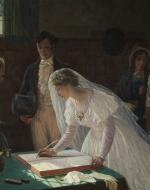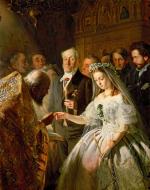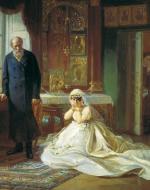Created by Leah Fraser on Fri, 03/01/2024 - 19:16
Description:
Introduction to Gallery
Throughout history, marriage has been seen as a special moment for women. It’s a day when a woman is dressed up, doted on by her family and friends, and is obtaining what people believe women want: a husband, and to become a mother. As Jerome Nadelhaft stated in his book, The Englishwoman’s Sexual Civil War: Feminist Attitudes towards Men, Women, and Marriage 1650-1740, “Their hot, moist humors made them overly passionate and emotional, sometimes more violent and rebellious. They were chatterers and scolds, flirts, and spend-thrifts. Only marriage justified their existence, providing companionship for men, a cure or moral outlet for lust, and a renewal of the species” (Nadelhaft, 555). This was how men viewed women and believed that a woman’s wedding day was their highest accomplishment, but most women were thinking differently. In the male gaze, women were perceived as beautiful and happy when they were wedded, but in the female gaze, women were upset by the realization of what was to come with their marriage. Several women throughout history were forced into marriages that they didn’t comply with and were labeled as “emotional brides” when the day came they were forced to marry a man for their wealth and status. As Mary Wollstonecraft stated in her work, A Vindication of the Rights of Woman, “It is acknowledged that they spend many of the first years of their lives in acquiring a smattering of accomplishments: meanwhile, strength of body and mind are sacrificed to libertine notions of beauty, to the desire of establishing themselves, the only way women can rise in the world—by marriage” (Wollstonecraft). Throughout this exhibit, four paintings will display the image of either a bride preparing for her wedding day or taking place on her wedding day. Two paintings will represent how men viewed the women’s perspective of their wedding day while the last two will reveal how women were feeling when the day came to be handed off to their husbands.
Work Cited:
Nadelhaft, Jerome. “The Englishwoman’s Sexual Civil War: Feminist Attitudes Towards Men, Women, and Marriage 1650-1740.” Journal of the History of Ideas, vol. 43, no. 4, 1982, pp. 555–79. JSTOR, https://doi.org/10.2307/2709343. Accessed 1 Mar. 2024.
Images in the Gallery
Fig. 1. Leighton, Edmund Blair. “Signing the Register” 1920s. Ancient Sculpture Gallery, https://www.ancientsculpturegallery.com/signing-the-register-by-edmund-blair-leighton.html/.
Edmund Blair Leighton was a painter who lived from 1852-1922 and was famously known for his Victorian-era art that displayed several themes of the medieval lives of knights and love within the period. Surprisingly, “Signing the Register” is one of his works that is barely shown in his great works. Several aspects within the painting display how a man viewed the wedding day for a woman. In the painting, the window in the top left corner is deliberately angled so that the sunlight casting in lands fully on the woman; only a few rays hitting the two men near her. This gives a holy glow to her as she signs her name into the register so that she is legally the wife of the man she is marrying. The light can also display the appeal of God due to the brilliance of sunlight shining upon the new bride, giving her an angelic light. This connects to Coventry Patmore’s book, Angel of the House, as he stated, “You, Sweet, his Mistress, Wife, and Muse,/ Were you for mortal woman meant?/ Your praises give a hundred clues/ To mythological intent!” (Patmore lines, 57-60). The woman displayed in the painting is viewed as an angel and a beautiful bride for the groom. This painting heavily displays how the male gaze believes that a woman’s big moment in her life is when she is a bride. The bride in the painting is at the center of the painting, illustrating that this is the only time when she will be the main attention within society.
Fig.2. Johnston, Alexander. “The Press Gang.” 1874. Art UK, https://artuk.org/discover/artworks/the-press-gang-78654.
Alexander Johnston, even though not vastly a well-known artist, had several paintings that were connected to mental health by creating paintings that displayed patients in mental facilities. “The Press Gang” still holds great value regarding the themes of marriage and what a woman was viewed for in the 1800s. The painting displays a man and a woman about to head to the courthouse to be married but is interrupted by another man. Even before marriage, the bride is defending her husband and the honor of his name. As Sarah Stickney Ellis stated in her work, The Women of England, Their Social Duties, and Domestic Habits, “The women of England, possessing the grand privilege of being better instructed than those of any other country, in the minutiæ of domestic comfort, have obtained a degree of importance in society far beyond what their unobtrusive virtues would appear to claim. The long-established customs of their country have placed in their hands the high and holy duty of cherishing and protecting the minor morals of life, from whence springs all that is elevated in purpose, and glorious in action” (Ellis). The painting fully displays her bond with her future husband, protecting his name and his honor as the man attacking them tries to harm him; she even knocks off his hat, showing a great sign of disrespect. This was viewed as a perfect wife but also displayed the perfect bride who has already started to form herself around her future husband.
Fig.3. Pukirev, Vasili Vladimirovits. “The Unequal Marriage.” 1862. Meisterdrucke, https://www.meisterdrucke.us/fine-art-prints/Vasili-Vladimirovits-Pukirev/146328/The-Unequal-Marriage%2C-1862-.html.
Vasili Vladimirovits Pukirev is one of the few artists in this gallery where the painting that is displayed is their most famous painting; his other works not gaining as much success or attention as “The Unequal Marriage”. Several aspects of the painting display the cruel reality that several women had to endure when they were married off. The bride is upset due to the marriage, her eyes red and cast downward as the priest places the ring on her finger. The bride is displayed in light colors to show that she is very young compared to her groom. The groom is greatly older than her, Pukirev paints the groom in dark colors to show his age and intentions with the bride. The painting displays that the young woman doesn’t want to marry. As John Stuart Mill stated in his work, The Subjection of Women, “Those who attempt to force women into marriage by closing all other doors against them, lay themselves open to a similar retort. If they mean what they say, their opinion must evidently be, that men do not render the married condition so desirable to women, as to induce them to accept it for its own recommendations” (Mill). There are also several hidden details in the painting that cast an even darker reality toward the bride. Several of the older men in the painting are gazing at the bride with the implication that they also want a young bride. Two older women are wearing wedding gowns near the groom; given several hints that they are either the groom’s deceased or divorced wives. Lastly, the young man behind the bride who is staring angrily at the groom is the painter, Pukirev, as if knowing the cruelty of forced marriages that were placed on women.
Fig. 4. Zhuravlev, Firs. “Before the Crown.”1874. Arthive, https://arthive.com/artists/687~Firs_Sergeevich_Zhuravlev/works/13248~Before_the_crown.
Firs Zhuravlev was a well-known Russian painter who had several paintings that portrayed and questioned social standings to the point that he was under police surveillance since they believed he had ties to revolutionary groups. “Before the Crown” displays a young bride collapsed on the floor, her face in her hands as she weeps. It’s the day of her wedding, and she doesn’t want to be a bride. Her father stands near her, his facial expression is hard to interpret if he’s upset with his daughter’s reaction to the arranged marriage or upset with himself that he’s forced her to do it. The fathers were the connection between their daughters to their future husbands; trying to find one that would add to the family's wealth and status. There is also a theory that he had struck her. As Virginia Woolf stated in her book, A Room of One’s Own, “She cried out that marriage was hateful to her, and for that she was severely beaten by her father. Then he ceased to scold her. He begged her instead not to hurt him, not to shame him in this matter of her marriage.” ( Woolf, Chapter 3). The painting also displays the bride’s mother peaking through the door, her face distraught at seeing her daughter upset. Zhuravlev has a painting that connects with this one called “After the Marriage”. It displays the bride after the marriage, her tearful face looking defeated as her new husband comes into the room she is in, his facial expressions showing what his intentions are with his new wife.
Work Cited:
Patmore, Coventry. ANGEL in the HOUSE: Book I. The Prologue. 1854. Coventry Patmore, 2016.
Ellis, Stickney Sarah. The Women of England. 1839. Sarah Stickney Ellis, 1 Mar. 2008.
Mill, Stuart John. On the Subjection of Women. 1869. London, Hesperus, 2008.
Woolf, Virginia. A Room of One’s Own. London, Hogarth Press, Sept. 1929.





